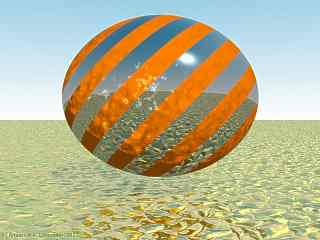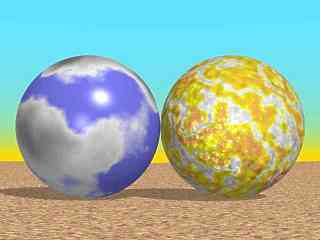Home
- POV-Ray Tutorial
Design of Surfaces
- Colors and Textures
Index
texture Syntax
Ready-made Textures
Do-it-yourself Colors
Patterns
> pattern types
Regular patterns
- checker, hexagon
square, triangular
- brick
- object pattern (1)
- object pattern (2)
- object pattern (3)
- tiling
- pavement
Stripes pattern
- color_map{...}
Patterns by pigments
- pigment_pattern (1)
- pigment_pattern (2)
- image_pattern
Patterns Lists
- Regular Patterns
- Random Patterns
- Fractal Patterns
- Other Patterns
Warps
Mapping
uv_mapping
Superpositions
Your own Textures
|
|
|
Patterns
"three-dimensional solid texturing" with prozedural 3d textures
|
Instead of a single color like "color Red",
we can use also a color pattern with the "pigment" statement.
Besides of the ready made color patterns like Jade, Bright_Blue_Sky, Blood_Sky,
Candy_Cane, Red_Marble, Brown_Agate, Cork etc., we can also
use a bundle of regular patterns (like checker, brick, spiral etc.) and
an infinite variety of irregular and floating patterns
by using a pattern type like "gradient<0,1,0>" and
a list of color or pigments to be used listed in a so-called "color_map"
or "pigment_map".
We also can use a pattern with a "texture_map" or a "normal_map".
Most of them work for "normal" as well as for colors.
These patterns were not only pasted on the surface of a geometric
object or wrapped around a shape like a wallpaper. They are
are three dimensional structures like the veins in a marble cake or in wood!
This method is called "three-dimensional solid texturing". The patterns
were produced by 3dimensional functions (apart from material_map, image_map and bump_map)
and this is why these textures are called processurale textures. Every point in
the 3d space has his own pattern property. If such a texture is applied to a shape
it's like cuting out a piece of marble cake. We can also scale, rotate, translate
them inside the "pigment" or "texture" bracket.
Turbulence brings live to the colors:
With the additional statement turbulence and values between
0.00 and 1.00 or more we modify each pattern. The attributes of pigment / normal
are variable. By this we can get nearly each kind of natural pattern structure,
like clouds, wood or marble.
See also
list of pattern types
for "pigment" und "normal"
Here an example for "crackle":
// ground ----------------------------------------------------
plane{<0,1,0>, 0
texture{Polished_Chrome
pigment{ color rgb<1,0.8,0>}
normal { crackle 0.75 turbulence 0.25 scale 0.25}
finish { diffuse 0.9}}
}// end of plane
//------------------------------------------------------------ |
For the texture of the above sphere see here:
layered textures
The following example is also know as "Bright_Blue_Sky" -
sphere{<0,0,0>,1 translate<-1,1,0>
texture{
pigment{
bozo turbulence 0.56
color_map {
[0.0 color rgb <0.5, 0.5, 1.0>] //LightBlue
[0.5 color rgb <0.5, 0.5, 1.0>] //LightBlue
[0.6 color rgb <1.0, 1.0, 1.0>] //White
[1.0 color rgb <0.5, 0.5, 0.5>] //Grey
} // end of color_map
} // end of pigment
finish { diffuse 0.9 phong 1}}}
// end of finish, end of texture, end of sphere |
sphere{<0,0,0>,1 translate<1,1,0>
texture{
pigment{
ripples scale 0.5 turbulence 1.5
color_map {
[0.0 color NeonPink ]
[0.1 color NeonPink ]
[0.5 color Yellow ]
[0.6 color White ]
[1.0 color Gray50 ]
} // end of color_map
} // end of pigment
normal { wrinkles 0.75 scale 0.1}
finish { diffuse 0.9 phong 1}}} |
|
|


